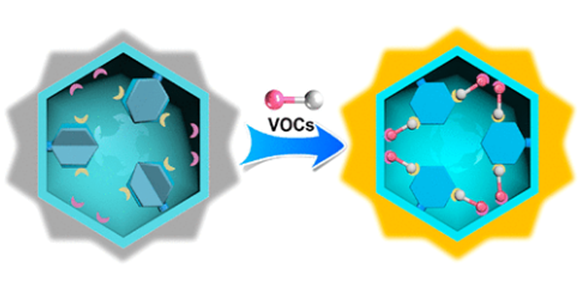Welcome to College of Chemistry, Chemical Engineering and Materials Science of Soochow
University
Ultrafast Luminescent Light-Up Guest Detection Based on the Lock of the Host Molecular Vibration
Chun-Yu Liu1,2, Xu-Ran Chen1, Hui-Xian Chen1, Zheng Niu1*(牛政),Hajime Hirao3*,Pierre Braunstein4, and Jian-Ping Lang1,2*(郎建平)
1College of Chemistry, Chemical Engineering and Materials Science, Soochow University, Suzhou 215123, Jiangsu, China
2State Key Laboratory of Organometallic Chemistry, Shanghai Institute of Organic Chemistry, Chinese Academy of Sciences, Shanghai 200032, China
3Department of Chemistry, City University of Hong Kong, Kowloon, Hong Kong SAR, China
4Institut de Chimie (UMR 7177 CNRS), Universitéde Strasbourg, 67081 Strasbourg, France
J. Am. Chem. Soc.2020,142, 6690--6697
Light-up luminescence sensors have been employed in real-time in situ visual detection of target molecules including volatile organic compounds (VOCs). However, currently employed light-up sensors, which are generally based on the aggregation-induced emission (AIE) or solvent-induced energy transfer effect, exhibit limited sensitivity for light-up detection and poor recycling performances thereby significantly hindering their industrial applications. Inspired by the low-temperature enhanced luminescence phenomenon, we herein propose and show that a guest-lock-induced luminescence enhancement mechanism can be used to realize the ultrafast light-up detection of target VOCs. Through introduction of chlorinated hydrocarbons to lock the molecular vibrations within a designed [Cu4I4]-based metal–organic framework (MOF), luminescence intensity could be enhanced significantly at room temperature. This guest-lock-induced luminescence enhancement is brought about by weak supramolecular interactions between the host framework and the guest molecules, allowing highly sensitive and specific detection of the guest vapor with ultrafast response time (<1 s). Single-crystal X-ray diffraction (SCXRD) analysis of guest molecules-loaded MOFs and density functional theory (DFT) calculations were employed to investigate the host–guest interactions involved in this phenomenon. Moreover, the above MOF sensor successfully achieved real-time detection of a toxic chloroaromatic molecule, chlorobenzene. The guest-lock-induced light-up mechanism opens up a route to discovering high-performance ultrafast light-up luminescent sensors for real-time detection applications.

链接:https://pubs.acs.org/doi/10.1021/jacs.0c00368